ABOVE: VIDEO OF DETROIT EFM VULTURE KEVYN ORR’S INTERVIEW WITH FREEP: EVERYTHING ON TABLE, LET’S PICK DETROIT’S BONES DRY.
Orr raises issues from “Root Cause Committee” report
Report falsified facts on other cities’ water/sewerage “authorities”
By Diane Bukowski with Tia Lebherz
March 19, 2013
DETROIT – “I think I’ve said everything’s on the table,” Detroit Emergency Financial Manager Kevin Orr told a Detroit Free Press editorial panel in the video above. “My operating assumption is there a net benefit to city and its residents. Water and Sewer for instance enjoys a higher bond rating than the city, operates on its own, has a positive net cash level, and provides services in a relatively good level. But if you’re able to do a structure with either a regional authority or privatization, it flows cash positive to city, $50 million with a 10 percent cap rate, half a million dollars. Everything—leasing, sale/leaseback, privatization, 99-year leases with a reversion to the city—everything’s on the table.”
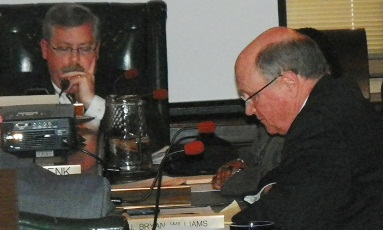
BOWC chair James Fausone and Oakland Co. rep. J. Bryant Williams appear to be deeply studying RCC report at meeting March 13, 2013. They couldn’t have studied TOO hard, as blatant falsehoods were rampant in report..
Orr thus has clearly studied a so-called “Root Cause Committee” report which the Detroit Board of Water Commissioners, (BOWC), voted 6-0 March 13 to approve in concept. BOWC Oakland County Commissioner The report recommended that the entire Detroit Water and Sewerage Department (DWSD) operate as an independent, autonomous public authority under the supervision of the BOWC, in exchange for an annual payment to the General Fund of $50 million. It cited fear of a takeover or bankruptcy under Orr’s governance. (Click on RCC report for whole report.)
Under the proposed structure, Detroit’s City Council would no longer have approval rights over contracts and rates. Currently, the City Council must approve all DWSD contracts over $2 million as well as rate hikes. The people of Detroit would lose their Charter-mandated right to vote on any sale or transfer of DWSD assets.
Tia Lebherz of Food and Water Watch told the BOWC her organization is opposed to the plan.
“This is a bad proposal, not in the best interests of the City of Detroit, and a path to privatization,” Lebherz said. “The Board of Water Commissioners is appointed and not accountable to the people. This will eliminate democratic control of our water resources. The Board has already voted to approve a $47 million contract with EMA, which proposes to cut 81 percent of the DWSD workforce. We need an elected and accountable water board.”
DWSD COO Matthew Schenk told the BOWC that the separation, which he termed a “lease,” would last for at least 30 years, depending on the pay-off of $6 billion in outstanding DWSD debt, and longer if more bonds are floated. After Oakland County’s BOWC member J. Bryan Williams objected that a proposed $50 million annual pay-off to Detroit’s general fund in exchange for DWSD, which has assets of over $6 billion, might not be affordable, Schenk the number is negotiable.
“The terms of any lease agreement are important,” BOWC board member Linda Forte, representing Detroit, countered. “We want total control of DWSD again. This is temporary…we should not be locked in.”
However, she voted “Yes,” as did Detroit’s other representatives Mary Blackmon and James Thrower, apparently not having reviewed the report for accuracy.
The report flagrantly falsified information about what it claims are six successful authorities in other cities. No one from the Root Cause committee, which unanimously approved the report (meaning City Council Pres. Charles Pugh and Pro-Tem Gary Brown signed on), the BOWC, the DWSD administration, or U.S. District Judge Sean Cox’s court apparently bothered to screen the document for factuality.
It is unclear if the report has even been presented to Cox, who appointed the Root Cause Committee. It is not posted on the federal court website, where previous Root Cause reports have been posted. It is unclear also whether Orr has any authority to act independently of Cox as a federal district judge.
The report and a separate Compliance Report issued by DWSD Director Sue McCormick recommend that federal oversight of DWSD be ended, after 36 years. It ignores the fact that litigation is still outstanding under the 1977 case from water department unions. AFSCME Local 207 and others challenged earlier orders from Cox changing DWSD governance and union rights before the U.S. Sixth Circuit Court of Appeals. The court has not yet rendered a decision.
Recommendations and conclusions in the entire report are suspect, if one examines blatant falsehoods it puts forward regarding other municipalities, which it claims have water and sewerage departments run successfully by “authorities.”
NEW YORK CITY
The report says, “The New York Municipal Water Authority was established by state law as a separate authority from the City of New York to manage the water and wastewater services for area residents. The Authority has a seven member board comprised of 4 ex officio New York City Directors, two mayoral appointments, and one gubernatorial appointment. The Authority holds the assets of the system pursuant to a lease agreement with the City and makes annual lease payments into the City’s general fund based upon a capped formula tied to total indebtedness.”
In fact, there is NO “New York Municipal Water Authority.”
According to New York City’s website and other sources, there is a “New York City Municipal Water FINANCE Authority.” Its sole purpose as a public benefit corporation established in 1985 is to finance the capital needs of the system through the issuance of bonds and other instruments.
It does NOT manage water and wastewater services. That is the responsibility of the New York City Department of Environmental Protection, which has 5,600 workers and is listed on the NYC government website as a regular city department. It is comprised of the Bureau of Water Supply, the Bureau of Water and Sewer Operations, and the Bureau of Wastewater Treatment. Its employees are regular city workers, represented in part by AFSCME District Council 37, among other public service sector unions.
A third entity, The New York City Water Board, sets water and sewer rates and collects payments from customers for services provided by the NYCEP. It has five board members appointed to two-year terms by the Mayor of New York City.
CLEVELAND, OHIO
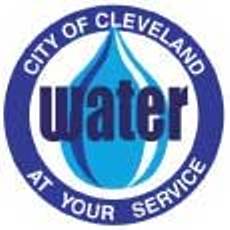 The report says, “The Northeast Ohio Regional Sewer District (“NEORSD”) was created by order of District Court Judge George McMonagle in April, 1972 in response to a lawsuit involving violations of the Clean Water Act. Prior to the Court’s involvement, the Sewer District was owned and operated by the City of Cleveland and served multiple jurisidictions . . .Through the litigation, Judge McMonagle ordered the transfer of assets by the City to a newly created public authority in Ohio.”
The report says, “The Northeast Ohio Regional Sewer District (“NEORSD”) was created by order of District Court Judge George McMonagle in April, 1972 in response to a lawsuit involving violations of the Clean Water Act. Prior to the Court’s involvement, the Sewer District was owned and operated by the City of Cleveland and served multiple jurisidictions . . .Through the litigation, Judge McMonagle ordered the transfer of assets by the City to a newly created public authority in Ohio.”
So far, so good. But sewage is sewage and water is water. The report completely neglects to cite the fact that Cleveland’s water supply services are provided by the City of Cleveland Public Utilities Department and its city workers, who are also unionized under AFSCME Local 100 and other labor organizations. Sewerage work is also included.
According to the city’s website, the Public Utilities department includes:
The city’s website says the city’s public governance of water and sewerage began in 1840.
LANSING BOARD OF WATER AND LIGHT
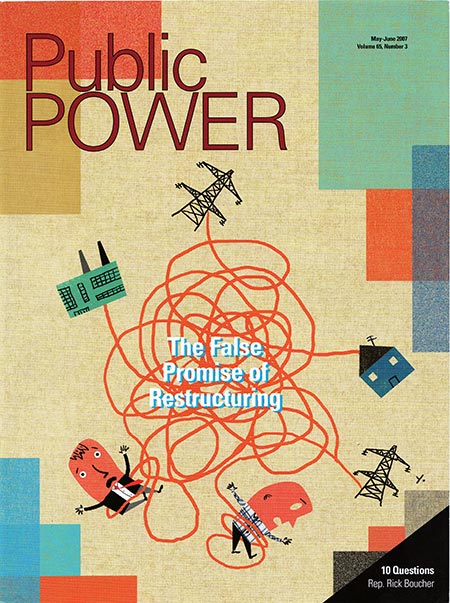 The RCC report says, “In Lansing, the Board members are appointed by the Mayor with Council ratification. The Board has full and final authority over all matters affecting the operation of the utility including contracting, rate setting, capital planning, hiring a Director, etc.”
The RCC report says, “In Lansing, the Board members are appointed by the Mayor with Council ratification. The Board has full and final authority over all matters affecting the operation of the utility including contracting, rate setting, capital planning, hiring a Director, etc.”
It says that the Lansing entity pays the city a total of five percent of sales according to a current five-year agreement.
The website for the Lansing BWL says however, “As a public power utility the Board of Water & Light is owned by its customers. While many utilities are investor-owned and managed to deliver profits into the pockets of stockholders, the BWL is managed to return value and benefits to the people it serves.
Lansing’s Board of Water and Light also provides electricity for Lansing residents at far cheaper rates than private utilities. While the BOWC is at it, if Detroit is going to emulate Lansing, why not have a public takeover of DTE and Consumers Power?
The City of Lansing website adds that sewerage services are provided through the city’s Public Service Department, using city workers.
“Wastewater Division is responsible for collection, pumping, processing and treatment of the city’s wastewater, and compliance with State pollution control regulations and the National Pollutants Discharge Elimination System (NPDES) program,” says the site. “This division, in conjunction with the Engineering Division, is also responsible for monitoring the Combined Sewer Overflow (CSO) systems. The city’s Wastewater Treatment Plant (WWTP) is the largest WWTP in the region with a current capacity of treating up to 50 million gallons of wastewater per day.
“The City operates the treatment facility under a National Pollution Discharge Elimination System permit issued by the Environmental Protection Agency and Michigan Department of Environmental Quality. The government has mandated that we treat the wastewater to specified levels of metals, nutrients, and chemicals before discharge to the Grand River.”
So much for speaking truth about power in Lansing.
LOUISVILLE WATER
Perhaps the most blatant falsehood put forward by the RCC involves its description of Louisville, Kentucky’s system which is in fact totally publicly owned and controlled by the city government. (VOD had to check to see if there is any other Louisville in the U.S., we were so astonished at the different versions presented. There is not.)
The RCC claims, “In Louisville, the Louisville Metro Mayor appoints all Board members and serves as an ex officio member. . . .The Board has total autonomy to make all decisions impacting operation of the utility with no other governmental oversight from the Metro Government. Annually, the utility pays a return on equity or dividend to its shareholder (Louisville.)”
The report says Louisville’s water system paid a total of $32.6 million to Louisville Metro.
Again, let’s take a look at Louisville’s website. LouisvilleWater.com is listed as a regular city department on Louisville’s government site.
“Louisville Water Company was incorporated in 1854,” says the government website. “On March 6, 1906, Kentucky State Legislature enacted legislation that called for the City of Louisville to become the sole stockholder of the company — at the time only 51 shares had remained in private hands. The act replaced the Board of Directors with the Board of Water Works and allowed the mayor to appoint four members, subject to approval by the aldermen. The act also stipulated that free water would be provided to the city and the company would become tax-exempt. The city would not be responsible for the company’s debt and all improvements had to be financed from income.”
The RCC took care to point out in its report that Michigan state law does not allow the free provision of water to anyone, but did not cite WHICH Michigan statute.
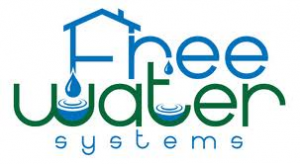 A report from the University of Louisiana says, “Louisville Water Company and American Federation of State, County and Municipal Employees Local 1683 have claimed the 13th annual labor-management award from the University of Louisville Labor-Management Center. . . . .Water company union and management leaders were praised for working together to improve quality and operations. As a result, water-related customer complaints have dropped by half and employee suggestions have saved the water company millions of dollars, award judges said.”
A report from the University of Louisiana says, “Louisville Water Company and American Federation of State, County and Municipal Employees Local 1683 have claimed the 13th annual labor-management award from the University of Louisville Labor-Management Center. . . . .Water company union and management leaders were praised for working together to improve quality and operations. As a result, water-related customer complaints have dropped by half and employee suggestions have saved the water company millions of dollars, award judges said.”
So—unionized Louisville city employees run the Louisville Water Company, in total contradiction to the implications made by the RCC.
WASHINGTON, DC WATER
“DC Water was created as an independent authority pursuant to a statute enacted in 1996,” says the RCC. “Under that framework, there is an independent board of directors created that has autonomy over all operations of DC water with very limited exceptions. The 11 member board is appointed by the Mayor . . The Board must receive Mayoral and District Council approval for any sale of a plant facility or any privatization of the entire plant operations. Also, DC retains all access rights to the waterfront on all DC Water property.”
 It says DC Water makes an annual payment to the city of Washington, D.C. of about $25 million a year under terms of a five-year Memorandum of Understanding, and that all assets are held by DC Water until all revenue bonds are repaid.
It says DC Water makes an annual payment to the city of Washington, D.C. of about $25 million a year under terms of a five-year Memorandum of Understanding, and that all assets are held by DC Water until all revenue bonds are repaid.
The report neglects to mention that Washington, D.C. does not have home rule. DC water was created in 1996 by both the city and the U.S. federal government.
Not long afterwards, DC Water became the focus a a huge scandal involving lead contamination of its water supply.
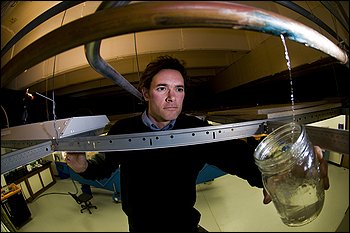
Marc Edwards in Washington Post article on his battle against lead contamination of DC Water supply.
In 2001, Marc Edwards, a civil engineering professor at Virginia Tech, found that DC water contained lead levels 83 times higher than safely acceptable. The national Centers for Disease Control and Prevention (CDC) claimed the water was nonetheless safe. But a Congressional investigation prompted by articles in the Washington Post found that the CDC had made “scientifically indefensible” claims about health effects from the lead.
Edwards found that the use of chloramine instead of chlorine to treat the water was responsible, with chloramine picking up lead from pipes and solder and dissolving it into the water. Lead is a serious health hazard, particularly in children, where it can cause brain damage, learning disabilities, tendencies to violence, and other adverse effects.
In 2010, the CDC reported that 15,000 DC area homes might still have water supplies with dangerous levels of lead.
So one would think that DC Water no longer uses chloramine. But an article in the Dcist Daily this month asks, “Does your tap water smell like a swimming pool?” It explains that one month a year, DC Water cleans out its pipes using chlorine, but continues to use chloramine the rest of the year.
In an email, Prof. Edwards confirmed that is the case.
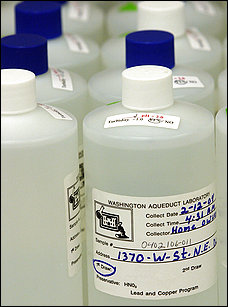
 “The lead pipes are still there, and still cause lead to be higher than the EPA LCR, but not in more than 10 percent of the homes,” Edwards said. “So officially they meet the action level. They started to dose orthophosphate in 2004, which seems to have helped keep the lead on the pipes. DC WASA was a horrible disaster of a utility through 2004, and probably through at least 2010 when their manager (Jerry Johnson) was fired and a new guy was hired. Three whistleblowers were fired for reporting safety problems from 2001-2004, and two won lawsuits against the utility, after years of consumers drinking water laced with high lead.”
“The lead pipes are still there, and still cause lead to be higher than the EPA LCR, but not in more than 10 percent of the homes,” Edwards said. “So officially they meet the action level. They started to dose orthophosphate in 2004, which seems to have helped keep the lead on the pipes. DC WASA was a horrible disaster of a utility through 2004, and probably through at least 2010 when their manager (Jerry Johnson) was fired and a new guy was hired. Three whistleblowers were fired for reporting safety problems from 2001-2004, and two won lawsuits against the utility, after years of consumers drinking water laced with high lead.”
So much for autonomous, independent control of a basic need of human life. And so much for the 10 percent of DC households whose children still drink lead-contaminated water.
INDIANAPOLIS
The RCC report says, “Indianapolis sold its public utility groups to Citizens Energy Group in 2011. CEG holds the assets as a not-for-profit public trust and is managed by a private board of directors. . . that nominates its own successors who shall be confirmed by the Mayor. . . The sale of the water and wastewater services to CEG by the City of Indianapolis included CEG assuming $1.5 billion of current indebtedness for a total price of approximately $1.9 billion, netting the City of Indianapolis $425 million to fund general fund expenses.”
The RCC did not report the real history of Indianapolis’ water system, which has been a rocky road indeed.
According to a study on water privatization, “Indianapolis purchased its water utility from the [private] Indianapolis Water Company in 2002 and immediately privatized the operation of the system. Veolia received the 20-year, $1.5 billion deal to manage the city’s water system. This had been Veolia’s largest water contract in the United States.
“Since then, workers, consumers and government officials alike have all had problems:
- Employees claimed the company cut their benefits by more than $50 million.
- Residents accused the company of using unfair billing practices and overcharging them.
- More than one million people were put on a boil alert in 2005 after a company employee entered a wrong code into a computer. This meant that before water could be safely used, it needed to be boiled. As a result, schools and businesses shut down and hotels and restaurants were forced to serve only bottled water.
- A city councilmember criticized the company for cutting back on staffing, water testing, treatment chemicals and maintenance, and other members questioned whether the company had a financial incentive to fudge quality tests.
“ . . . .A controversial contract amendment signed in 2007 shifted millions of dollars in liabilities from the company to the city while increasing city’s annual payment to the company by $1.9 million. In total, the amendment cost the city more than $144 million. State regulators refused to allow the city to recoup some of these additional expenses in a rate increase.
“By 2010, with infrastructure needs mounting, the city opted to wash its hands of the water utility altogether and decided to sell it, along with the sewer system, to the nonprofit Citizens Energy Group. As part of the transfer, the city agreed to pay Veolia $29 million to terminate its contract early. Citizens Energy believed it could realize savings not possible within the constraints of the contract.
So, Indianapolis Water and Sewerage was publicly controlled for only a brief period of time, and its subsequent privatization of the system resulted in disaster for the city.
So much for Kevyn Orr’s alternative of privatization for DWSD.
Orr, the BOWC, the RCC, the DWSD administration, Mayor Dave Bing, Governor Rick Snyder and their corporate/banker backers need to be charged with fraud and obstruction of justice for perpetrating this flagrant hoax on the people of the City of Detroit, not to mention a federal judge.









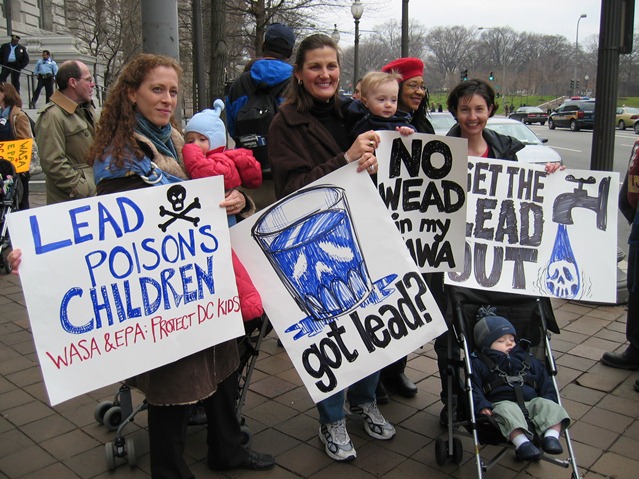

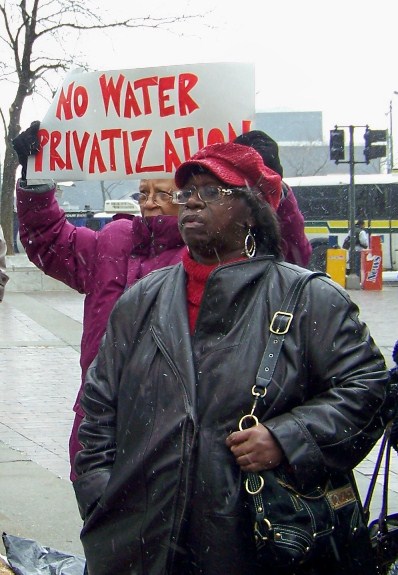
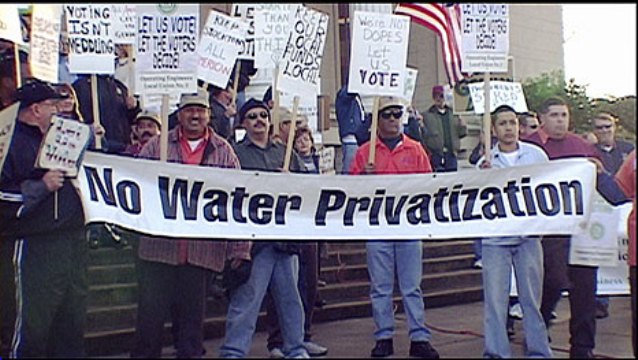




Fausone conveniently ignores his conflict of interest by being Westland City attorney and DBOWC chairman as well de facto leader of root cause committee. Judge Cox should remove him from the public trough.